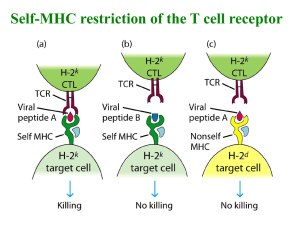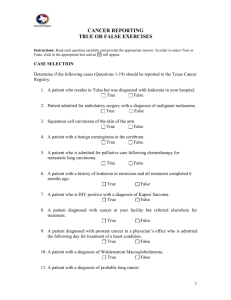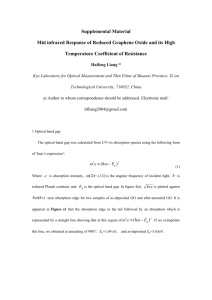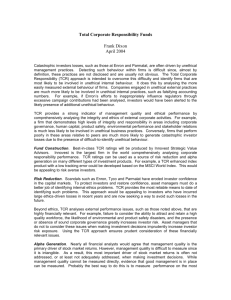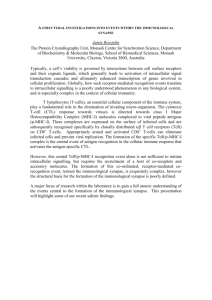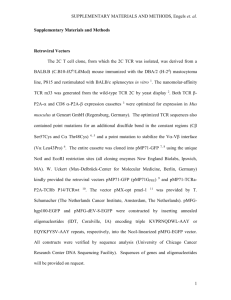The Roles of Serial Engagement and Kinetic
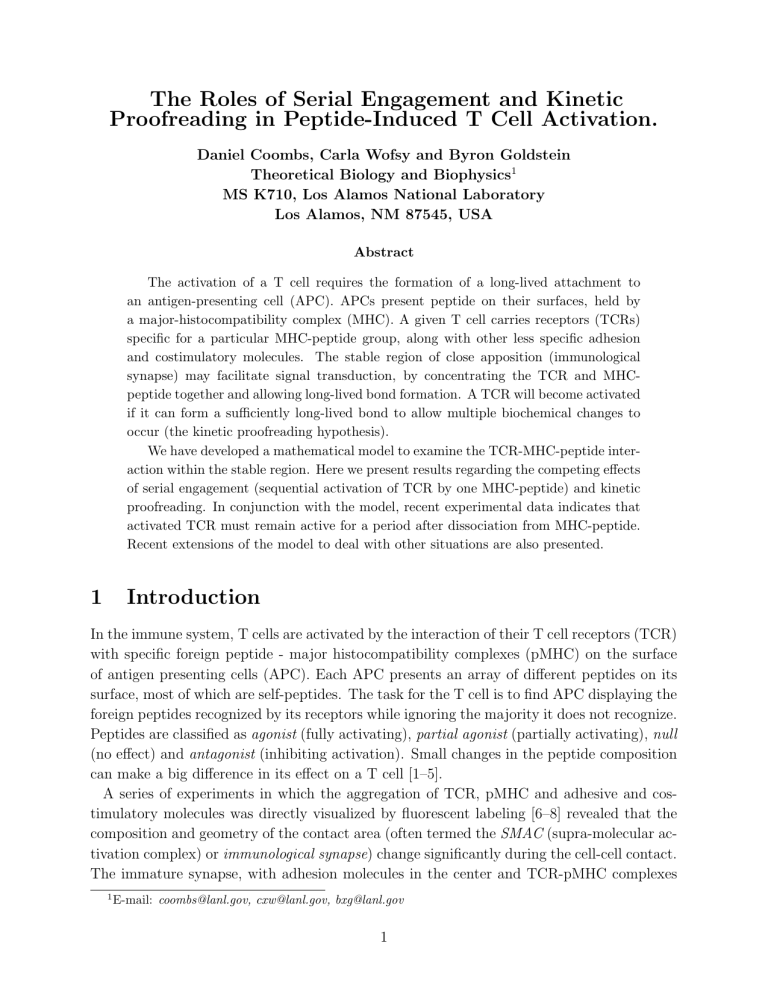
The Roles of Serial Engagement and Kinetic
Proofreading in Peptide-Induced T Cell Activation.
Daniel Coombs, Carla Wofsy and Byron Goldstein
Theoretical Biology and Biophysics 1
MS K710, Los Alamos National Laboratory
Los Alamos, NM 87545, USA
Abstract
The activation of a T cell requires the formation of a long-lived attachment to an antigen-presenting cell (APC). APCs present peptide on their surfaces, held by a major-histocompatibility complex (MHC). A given T cell carries receptors (TCRs) specific for a particular MHC-peptide group, along with other less specific adhesion and costimulatory molecules. The stable region of close apposition (immunological synapse) may facilitate signal transduction, by concentrating the TCR and MHCpeptide together and allowing long-lived bond formation. A TCR will become activated if it can form a sufficiently long-lived bond to allow multiple biochemical changes to occur (the kinetic proofreading hypothesis).
We have developed a mathematical model to examine the TCR-MHC-peptide interaction within the stable region. Here we present results regarding the competing effects of serial engagement (sequential activation of TCR by one MHC-peptide) and kinetic proofreading. In conjunction with the model, recent experimental data indicates that activated TCR must remain active for a period after dissociation from MHC-peptide.
Recent extensions of the model to deal with other situations are also presented.
1 Introduction
In the immune system, T cells are activated by the interaction of their T cell receptors (TCR) with specific foreign peptide - major histocompatibility complexes (pMHC) on the surface of antigen presenting cells (APC). Each APC presents an array of different peptides on its surface, most of which are self-peptides. The task for the T cell is to find APC displaying the foreign peptides recognized by its receptors while ignoring the majority it does not recognize.
Peptides are classified as agonist (fully activating), partial agonist (partially activating), null
(no effect) and antagonist (inhibiting activation). Small changes in the peptide composition can make a big difference in its effect on a T cell [1–5].
A series of experiments in which the aggregation of TCR, pMHC and adhesive and costimulatory molecules was directly visualized by fluorescent labeling [6–8] revealed that the composition and geometry of the contact area (often termed the SMAC (supra-molecular activation complex) or immunological synapse ) change significantly during the cell-cell contact.
The immature synapse, with adhesion molecules in the center and TCR-pMHC complexes
1 E-mail: coombs@lanl.gov, cxw@lanl.gov, bxg@lanl.gov
1
in an outer ring, matures over a few minutes so that TCR-pMHC become located in an inner region surrounded by adhesion molecules. In recent experiments where naive T cells interact with APC, the immature synapse persists for a longer period (15–30 min) and early signaling events occur before the mature synapse forms [8]. Theoretical work [9] suggests that formation of a stable synapse is controlled by the binding properties of the specific peptide-MHC with TCR.
Recent studies [4, 10] have shown that there is an optimal lifetime for the pMHC-TCR bond. T cell activation and internalization rise as a function of this lifetime, go through a maximum, and then decline. This was predicted by Lanzavecchia et al. [11] because of competition between the following two effects:
1 The pMHC-TCR bond must last sufficiently long for a series of biochemical modifications to occur (phosphorylations of immunoreceptor tyrosine-based activation motifs
(ITAMs), association of ZAP-70, activation of ZAP-70 etc.), ending with a fully triggered TCR. Successful T cell stimulation by a given presented peptide therefore requires a long pMHC-TCR bond lifetime. [12, 13]
2 At physiological low pMHC densities on the APC, each pMHC may sequentially interact with many different TCR. This effect is maximized by a short pMHC-TCR bond lifetime. [14, 15]
Here, we show how a mathematical model of pMHC-induced TCR down regulation / stimulation can be used to examine the conditions under which the trade-off exists, with surprising results. We also use the model to examine whether TCR aggregation in association with specific peptide binding is necessary for down-regulation, and to look in qualitative terms at the maturation of the T cell response after exposure to viral peptides.
2 Mathematical Model
The model is presented elsewhere [10]. Here, we briefly summarize our modeling assumptions and give the equations which define the mathematical model.
We consider a situation where a mature “immunological synapse” [7] has formed rapidly after the two cells have made contact. The contact region is taken to be uniform and circularly symmetric with radius a , and initially to contain given concentrations of pMHC and TCR, which subsequently react and diffuse. We write the concentration of TCR and pMHC as T ( r, t ) and P ( r, t ), with initial conditions T ( r, 0) = T
0 and P ( r, 0) = P
0
. We assume the contact region is of fixed size and shape and do not model its formation [9].
Our conclusions are, in any case, essentially geometry-independent. TCR and pMHC are assumed to freely diffuse over the cell surface, with diffusion coefficients D
T and D
P
.
TCR and pMHC may bind only within the contact region, with fixed forward (twodimensional) and reverse rate constants ¯ on and k off
[16], to form the (first) bound state
B
0
( r, t ). We model the series of biochemical modifications the bound state undergoes using
2
a kinetic proofreading model [12] as follows (Figure 1): After undergoing N modifications, a TCR is activated and becomes subject to internalization. We assume that these modifications are effectively irreversible, with a common forward rate constant, k p
. At all times, though, the bound state is subject to unbinding (with rate constant k off which we assume returns the TCR to its initial, unmodified state. We call the concentration of the activated free TCR state consists of a T ∗
T ∗ ( r, t ) and of the sequence of bound states B bound to a P .
i
( i = 0 . . . N ), where B
N
Different assumptions regarding how an activated TCR becomes internalized lead to different predictions of how the rate of down-regulation will depend on k off
. We introduce distinct internalization rates to permit different possibilities, as follows: TCR bound to pMHC which have been fully modified (the B
N state) are internalized with rate λ
B
. If an activated TCR separates from the pMHC, it becomes internalized at a rate λ
T
, as long as it remains in the contact region. Outside the contact region, it reverts to an inactivated state with rate µ . It may also rebind with a free pMHC to form a B
N complex.
Within the contact region, the governing equations are
∂T /∂t = D
T
∇
2 T −
¯ on
T P + k off
N − 1
X
B i i =1
∂P/∂t = D
P
∇
2 P −
¯ on
( T + T ∗ ) P + k off
N
X
B i
+ λ
B
B N i =0
∂B
0
/∂t = D
B
∇
2
B
0
+ ¯ on
T P − ( k off
+ k p
) B
0
∂B i
/∂t = D
B
∇
2 B i
+ k p
B i − 1
− ( k off
+ k p
) B i
( i = 1 , . . . , N
∂B
N
/∂t = D
B
∇
2 B
N
+ ¯ on
T ∗ P + k p
B
N − 1
− ( k off
+ λ
∂T ∗ /∂t = D
T
∇
2
T −
Z dT i
/dt =
¯ on
( λ
T
T ∗
T
+
∗ P + k off
B
N
− λ
T
T
λ
B
B
N
) dA
∗ contact
B
) B
N
− 1)
(2.1)
(2.2)
(2.3)
(2.4)
(2.5)
(2.6)
(2.7)
We impose a no flux-boundary condition on B i states at the boundary of the contact region.
We deal with other boundary conditions by introducing a region which surrounds the contact area. Within this region, pMHC and TCR freely diffuse. Activated TCR may also be internalized or revert back to the inactive state. Within this transition region, we have
∂T /∂t = D
T
∇
2
T + µT ∗
∂T ∗ /∂t = D
T
∇
2 T ∗ − µT ∗ − λ
T
T ∗
∂P/∂t = D
P
∇
2 P
(2.8)
(2.9)
(2.10)
Outside the transition region, we assume that TCR and pMHC are well mixed and that
T ∗ = 0. These assumptions, together with a conservation law for the total number of TCR and pMHC associated with the respective cells, give boundary conditions for T , T ∗ and
P . We can numerically integrate equations (2.1–2.10) using physiological parameter values
[10, 16].
3
T k on k off
B
0 k off k off k p k off k p k off k p k off
+
λ
B
B
1
B
2 k off k on
B
N
λ
B
T*
λ
T
Figure 1: The monomer model for TCR internalization. A pMHC-bound TCR that undergoes N modifications can be internalized and degraded.When a fully modified TCR dissociates it remains activated and subject to internalization unless it diffuses out of the contact area, where it can revert to its basal state.
3 Results
Kinetic Proofreading and Serial Engagement Experimental data for the relationship of both T cell activation and TCR internalization to k off show an optimal value of k off
. Using our model, we can examine under what conditions we see a maximum in internalization. The key insight, described fully in [10], is that the existence of a maximum depends critically on how we allow TCR to be internalized. If TCR may be internalized only after unbinding
( λ
B
= 0), then a maximum is guaranteed for both internalization and activation of TCR.
If λ
B
= 0 then the existence of the experimentally observed maxima depends on other parameters of the problem. If λ
T
= 0 then no maximum in internalization can exist. This is essentially because the internalization provides a way to free pMHC, thus increasing the efficiency of serial engagement. The prediction we make is that activated TCR must remain subject to internalization for a period after they unbind from pMHC. We have shown, using physiological parameters, that this period must be at least 2–3 minutes.
In Figure 2, we show that a simple consequence of the model is that the response to a peptide is essentially controlled by k off
, in agreement with the data. We also see that the level of TCR response is only weakly dependent on k on
, provided k on
T À 1, which is the case (at least for short times) in the biological situation.
4
3x10
4 a
2x10
4
1x10
4
0
0.001 0.01 0.1 1 k (s
-1
)
Figure 2: Computed levels of TCR internalization as a function of k off
, for two values of k on
.
¤ points correspond to k on
= 10 − 10 cm − 2 s − 1 ; • points to k on
= 5 × 10 − 11 cm − 2 s − 1 . Other parameters are T (0) = 6 × 10
µ = 0 .
1 s − 1 , N = 6, k p
9
= 0 .
25 s − 1 .
cm − 2 , P (0) = 2 × 10 8 cm − 2 , λ
B
= 0, λ
T
= 3 × 10 − 3 s − 1 ,
Maturation of the T cell response In the case of CD8+ T cells, it has been observed that the level of presented viral peptide on the APC required to trigger a response decreases with time since viral infection [17]. Additional experiments [17, 18] show that this may be due to an increase in the amount of the enzyme Lck (key in TCR triggering) associated with the plasma membrane. The binding kinetics of pMHC to TCR are not affected. In our model, increasing the level of a key enzyme in the signaling cascade would correspond to increasing the parameter k p
. This has two effects. Firstly, we note that if activated TCR are internalized solely after dissociating from pMHC, the optimal k off for internalization is given by k max off
≈ k p
/ ( N − 1). Therefore, after exposure to viral peptides, k max off will increase.
Secondly, there will be a general broadening of the curve of TCR internalized against k off
[10]. In other words, weak agonist pMHC (those with a high k off
) will achieve greater levels of TCR internalization after previous stimulation of the T cell with viral peptides. Serial engagement is not affected, but kinetic proofreading becomes more efficient.
4 Discussion
Conclusions
We have presented a model for the activation and internalization of TCR during antigenic stimulation that includes the effects of TCR and pMHC diffusion, and kinetic proofreading.
5
Our first conclusion is that the existence of an optimal pMHC-TCR bond lifetime for
TCR activation (as predicted earlier) does not guarantee an optimal lifetime for TCR down regulation. For such an optimum to exist, an activated TCR must remain subject to down regulation for a period of time following its dissociation from the pMHC. The fact that experiments have shown this maximum to exist implies that this phenomenon occurs.
Our second conclusion is that increasing the concentration or accessibility of parts of the
TCR signaling pathway will tend to increase the sensitivity and decrease the specificity of the T cell for pMHC. Conversely, if the T cell content (or accessibility) of such an enzyme goes down, we predict an increased specificity, or narrowing of the range of pMHC that can trigger the cell. It has been shown experimentally [19] that Zap-70 (an important kinase in T cell signal transduction) is down regulated along with TCR during exposure of T cells to antigen presenting cells. We speculate that it is possible that the effect could be large enough that pMHC able to bind specific TCR and elicit successful TCR down-regulation in the early stages of the cell-cell contact may lose this ability after the available pool of Zap-70 is depleted.
Future Directions
Constitutive down-regulation It is known that, even in the absence of antigenic stimulation, TCR are routinely internalized and recycled to the cell surface, as well as being produced and expressed on the cell surface [20]. The rate at which surface TCR are internalized is found to be 1–2% per minute in the absence of APC, but their presence is not believed to increase this rate. However, the presence of APC with appropriate antigens will decrease the rate at which internalized TCR are recycled to the cell surface.
Constitutive recycling with a characteristic half-life can be built into the model presented above by assuming that an internalized TCR must pass through a set of states before it is recycled. Untriggered TCR are internalized at some rate λ
0 and move into the first recycling state. They then pass through the states, and eventually are returned to the cell surface with a uniform rate. The possibility of production of new TCR and removal from recycling of the internalized TCR is also simple to add.
TCR Oligomerization It remains unclear how the information that a TCR-pMHC bond has formed is passed across the T cell plasma membrane in the immunological synapse [21].
One class of models proposes that TCR activation is initiated when pMHC binds and induces
TCR aggregation. Experiments with soluble monomers and oligomers of pMHC show that the formation of TCR dimers or higher oligomers is enough to stimulate T cells and trigger
TCR internalization, whereas monomers do not suffice [22-26]. The question of whether oligomerization occurs in the immunological synapse remains open. It has been argued that a requirement for TCR dimerization is inconsistent with TCR activation being most efficient at low peptide densities [11, 21]. To address these questions, we may develop a very similar model in which bound pMHC-TCR must aggregate into dimers before the TCR can begin
6
to be modified.
Effects of self-peptide Recent data [27] shows the interesting result that TCR activation due to specific pMHC is boosted by the addition of non-specific (self) peptide to the APC.
Different mechanisms [28] have been proposed to explain this phenomenon, but without use of a quantitative model it is difficult to distinguish them. Modifying the model described above to allow for two peptides with distinct kinetics and concentrations is not difficult, and will allow us to make testable predictions.
Acknowledgments This work was supported by NIH grant GM35556 and performed under the auspices of the US Department of Energy. We thank Alexis Kalergis for useful discussions.
References
[1] Hudrisier, D., Kessler, B., Valitutti, S., Horvath, C., Cerottini, J-C., & Luescher, I.F.
(1998) J. Immunol.
161 , 553–562.
[2] Ding, Y.H., Baker, B.M., Garboczi, D.N., Biddison, W.E., & Wiley, D.C. (1999) Immunity 8 , 403–411.
[3] Baker, B.M., Gagnon, S.J., Biddison, W.E., & Wiley, D.C. (2000) Immunity 13 , 475–
484.
[4] Kalergis, A.M., Boucheron, N., Doucey, M.-A., Palmieri, E., Goyarts, E.C., Vegh, Z.,
Luescher, I.G., & Nathenson, S.G. (2001) Nature Immunol.
2 , 229–234.
[5] Kalergis, A.M., & Nathenson, S. G. (2000) J. Immunol.
165 , 280-285.
[6] Monks, C.R., Freiberg, B.A., Kupfer, H., Sciaky, N., & Kupfer, A. (1998) Nature 395 ,
82-86.
[7] Grakoui, A., Bromley, S.K., Sumen, C., Davis, M.M., Shaw, A.S., Allen, P.M., & Dustin,
M.L. (1999) Science 285 , 221–227.
[8] Lee, K-H., Holdorf, A.D., Dustin, M. L., Chan, A. C., Allen, P. M., & Shaw, A. S.
(2002) Science 295 , 1539–1542.
[9] Qi, S.Y., Groves, J.T., & Chakraborty, A.K. (2001) Proc. Natl. Acad. Sci. USA 98 ,
6548–6553.
[10] Coombs, D., Kalergis, A.M., Nathenson, S.G., Wofsy, C., & Goldstein, B. (2002) Submitted.
7
[11] Lanzavecchia, A., Lezzi, G., & Viola, A. (1999) Cell 96 , 1–4.
[12] McKeithan, K. (1995) Proc. Natl. Acad. Sci. USA 92 , 5042–5046.
[13] Hlavacek, W.S., Redondo, A., Metzger, H., Wofsy, C. & Goldstein, B. (2001) Proc. Natl.
Acad. Sci. USA 98 , 7295-7300.
[14] Vallitutti, S., M¨ Nature
375 , 148–151.
[15] Itoh, Y., Hemmer, B., Martin, R., & Germain, R.N. (1999) J. Immunol.
162 , 2073–2080.
[16] Wofsy, C., Coombs, D., & Goldstein, B. (2001) Biophys. J.
80 , 606–612.
[17] Slifka, M.K., & Whitton, J.L. (2001) Nature Immunol.
2 , 711–717.
[18] Bachmann, M.F., Gallimore, A., Linkert, S., Cerundolo, V., Lanzavecchia, A., Kopf,
M., & Viola, A. (1999) J. Exp. Med.
189 , 1521–1529.
J. Immunol.
163 , 50–56.
[20] Liu, H., Rhodes, M., Wiest, D.L., & Vignali, D.A.A. (2000) Immunity 13 , 665–675.
[21] van der Merwe, P.A. (2001) Immunity 14 , 665–668.
[22] Abastado, J.P., Lone, Y.C., Casrouge, A., Boulot, G., and Kourilsky, P. (1995) J. Exp.
Med.
182 , 439–447.
[23] Hamad, A.R., O Herrin, S.M., Lebowitz, M.S., Srikrishnan, A., Bieler, J., Schneck, J.,
& Pardoll, D. (1998) J. Exp. Med.
164 , 1988–2005.
[24] Boniface, J.J., Rabinowitz, J.D., W ulfing, Hampl, J., Reich, Z., Altman, J.D., Kantor,
R.M., Beeson, C., McConnell, H.M., & Davis, M.M. (1998) Immunity 9 , 459–466.
[25] Appel, H., Gauthier, L., Pyrdol, J., & Wucherpfennig, K.W. (2000) J. Biol. Chem.
275 ,
312–321.
[26] Cochran, J.R., Cameron, T.O., & Stern, L.J. (2000) Immunity 12 , 241–250.
(2002) Nature Immunol.
3 , 42–47.
[28] Baker, T.R. & van der Merwe, P. (2002) Nature Immunol.
3 , 11–12.
8


